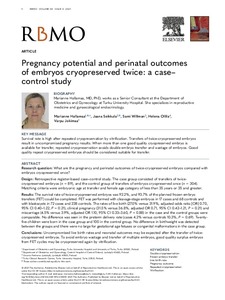Pregnancy potential and perinatal outcomes of embryos cryopreserved twice: a case–control study
Hallamaa Marianne, Seikkula Jaana, Willman Sami, Ollila Helena, Jokimaa Varpu
https://urn.fi/URN:NBN:fi-fe2021093047886
Tiivistelmä
Research question
What are the pregnancy and perinatal outcomes of twice-cryopreserved embryos compared with embryos cryopreserved once?
Design
Retrospective register-based case–control study. The case group consisted of transfers of twice-cryopreserved embryos (n = 89), and the control group of transfers of embryos cryopreserved once (n = 304). Matching criteria were embryonic age at transfer and female age category of less than 35 years or 35 and greater.
Results
The survival rate of twice-cryopreserved embryos was 92.2%, and 93.7% of the planned frozen embryo transfers (FET) could be completed. FET was performed with cleavage-stage embryos in 17 cases and 68 controls and with blastocysts in 72 cases and 238 controls. The rates of live birth (27.0% versus 31.9%, adjusted odds ratio [OR] 0.70, 95% CI 0.40–1.22, P = 0.21), clinical pregnancy (31.5% versus 36.8%, adjusted OR 0.71, 95% CI 0.42–1.21, P = 0.21) and miscarriage (4.5% versus 3.9%, adjusted OR 1.10, 95% CI 0.33–3.60, P = 0.88) in the case and the control groups were comparable. No difference was seen in the preterm delivery rate (cases 4.2% versus controls 10.3%, P = 0.69). Twenty-five children were born in the case group and 100 in the control group. No difference in birthweight was detected between the groups and there were no large for gestational age fetuses or congenital malformations in the case group.
Conclusions
Uncompromised live birth rates and neonatal outcomes may be expected after the transfer of twice-cryopreserved embryos. To avoid embryo wastage and transfer of multiple embryos, good quality surplus embryos from FET cycles may be cryopreserved again by vitrification.
Kokoelmat
- Rinnakkaistallenteet [19207]
